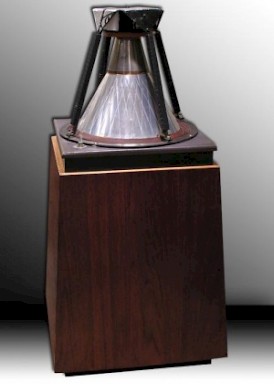Are Single-driver Designs Better Than Multi-driver Designs?
There are many claims about the advantages of one design over the other. Each side has valid arguments and many misconceptions. We will discuss most of the major points of contention. There is no current speaker on the market that is best in every characteristic. There may never be such a device. You will have to accept limitations in some areas to get better performance in other areas.
Tried and True
Historically, the Western Electric models from the 1940’s are considered some of the best full-range, single-driver systems. Yes, the same Western Electric that designed and manufactured your parents’ telephones. Collectors now pay several thousand dollars for the 12” versions. The very popular 8” version used in phone systems still has a big following. The amplifiers of the day were quite small, so the efficiency had to be high. Since voice was their primary goal, deep bass and extended treble were traded for midrange clarity and efficiency.

The Ohm A of 1973 was one of the few single-driver systems with a frequency response of 25-17,000 Hz and reasonable sound output levels. We achieved the frequency extension by accepting lower efficiency. The old joke was that it took 300 watts to get them going and 301 watts to blow them up. Both were wrong; but you get the idea.
Today, an interesting single-driver system comes from California manufacturer, Audience. Its “One” speaker, officially, “Clair Audient One”, uses a 3” driver with 84 dB efficiency. When used in the correct cabinet it has a response of 40 Hz - 22 kHz – quite impressive and it can sound quite good.
Efficiency
There is a real dilemma with a single-driver system. The treble response is inversely related to the mass of the voice coil. That is to say, the lighter the voice coil, the more extended the treble. Regrettably, the bass response is directly related to the mass of the voice coil. The heavier the voice coil, the deeper the bass response.
Rule of 400,000
Now comes in the “Rule of 400,000” (that I heard Western Electric developed in the 1930’s or earlier). It basically stipulates that to have a natural sounding speaker, the frequency of the low roll off is multiplied by the high frequency roll off, the results should about 400,000. If you have a low frequency response down to 80Hz, you only want treble response to 5,000Hz – neither higher nor lower. This covers the demands for voice reproduction quite satisfactorily. So, if you need only voice reproduction, you can have high efficiency; but if you want full music reproduction from a single-driver system, you will have to have low efficiency.
With a multi-driver system, you can have a subwoofer (or woofer) with a massive voice coil for acceptable efficiency matched with an equally efficient tweeter with a very light voice coil. Or maybe even add a midrange of similar efficiency to get the crossover out of the voice range.
Crossovers
Several full blogs could be written about the pros and cons of crossovers and their designs. Since any crossover will change the sound, a single-driver system (which needs none) will win this debate every time – no contest.
Dispersion
Dispersion is a bit like efficiency: the frequency range has big effects. Low, low bass is omnidirectional with all monopoles used in homes no matter what their size. As you go up in frequency, forward firing drivers become more and more directional in the forward direction. It takes a small driver to have wide dispersion at higher frequencies. Even a 1” driver is very directional at 10,000 Hz!
Now, the early Walsh speakers had 360o of near perfect horizontal dispersion and controlled vertical response to reduce floor and ceiling bounce of treble. Still, this was not ideal as the rear and side radiation forced the speakers to be placed far from walls to eliminate comb-filtering from the reflections. This is not a user-friendly feature!
Coherence
Once again a topic for another blog. Since music is a bunch of short events, overlapping and following each other, your mind can best discriminate when the overtones of the start of an event come at the same time. This is a major problem with multi-driver systems while single-driver systems are naturally correct.
Maximum output
If you accept low output you can make a quite satisfactory speaker like the One as a single-driver system. If you want high output, you are pretty much limited to big, multi-driver designs. The designs of the day determine at what loudness level and what size driver the benefits of multi-driver systems surpass the benefits of single-driver systems.
Today’s Ohm Walsh speakers are two-driver systems that sound and measure like single-driver systems from any normal listening position. So, my answer to the title question is both.
Subscribe to Ohm News & Views to get the latest posts in your inbox
John Strohbeen Author
John Strohbeen was the President and Chief Engineer of Ohm Acoustics from 1978-2023.


